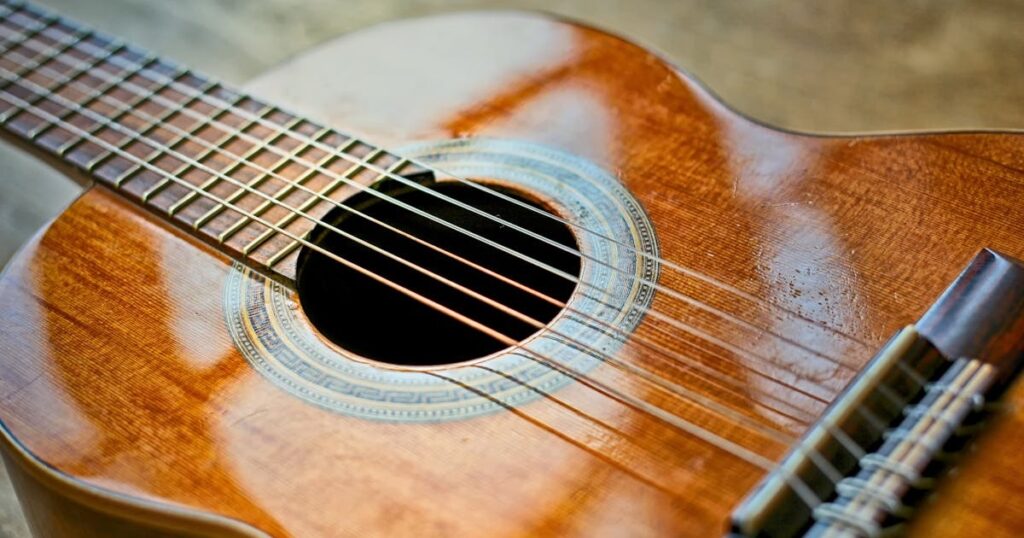Key takeaway: Light acoustic guitar string gauges cater to various playing styles and preferences. Understanding the differences between extra light, custom light, and medium gauges is essential for musicians to achieve optimal tone, playability, and comfort in their performances.
When it comes to playing acoustic guitar, one of the most important factors that can greatly affect your sound is the type of string gauge you use. In simple terms, string gauge refers to the thickness or diameter of a string.

For acoustic guitars, there are various light gauges available in the market, each with its own unique characteristics and benefits. In this article, we will focus on three commonly used light acoustic guitar string gauges – Extra Light (10-50), Custom Light/Super Light (11-52), and Medium (13-56).
We will dive into their individual features, advantages, and who they are best suited for. So whether you’re a beginner looking to explore different string options or a seasoned player in search of the perfect strings, this article has got you covered.
Extra Light Gauge (10-50)
As the name suggests, extra light gauge strings are the thinnest and most delicate of the three gauges mentioned in this article. They typically have a thickness range of 10-50, with the first string being 0.010 inches and the sixth string being 0.050 inches.
Extra light gauge strings offer excellent playability, making them ideal for beginners or players with smaller hands. They require less finger pressure to fret and bend, making it easier to produce clear and clean notes. Additionally, their thinness also results in a bright and crisp sound, giving your guitar a more “jangly” tone.
These strings are also perfect for fingerpicking styles as they allow for faster movements across the fretboard. However, one downside of extra light gauge strings is that they tend to break more easily due to their thinness. So if you’re someone who plays with a heavy hand or aggressively strums, these may not be the best option for you.
Who and What Are They For?
Extra light gauge strings are often recommended for beginners or players who have just started learning the guitar. They offer an ease of playability that helps build up hand strength and dexterity. Additionally, they are also ideal for players who primarily play fingerstyle or light strumming styles.
These strings are also great for acoustic players who want a brighter tone with more treble and less bass. They work well with smaller-bodied guitars as their thinness complements the natural brightness of these instruments.
Custom Light or Super Light Gauge (11-52)
Custom light or super light gauge strings have a slightly thicker diameter than extra light strings, with a range of 11-52. The first string is usually 0.011 inches, while the sixth string is 0.052 inches.

The main advantage of custom light/super light gauge strings is that they offer a good balance between playability and tone. They provide enough thickness for added volume and sustain while still being easy to play. The increased string tension also makes them less prone to breaking compared to extra light strings.
Additionally, these strings work well with both fingerstyle and strumming techniques, making them a versatile choice for various playing styles. They also produce a warmer tone than extra light strings but still retain some of the brightness.
Who and What Are They For?
Custom light or super light gauge strings are suitable for players who have developed some hand strength but still prefer lighter gauges. They are also great for players who switch between fingerpicking and strumming techniques, as their balanced tone works well for both.
These strings are also recommended for acoustic players who want a fuller sound with more sustain and bass. They work well with medium-sized guitars, adding depth and richness to the instrument’s natural tonal qualities.
Medium Gauge (13-56)
The heaviest of the three gauges mentioned in this article, medium gauge strings have a thickness range of 13-56. The first string is usually 0.013 inches, while the sixth string is 0.056 inches.
Medium gauge strings offer the most volume and projection out of all the light gauges. They produce a rich and full-bodied sound with deep bass and clear treble notes. These strings also offer a tighter and more responsive feel, making them ideal for players who play with force and want to feel the resistance of the strings.
However, due to their thickness, medium gauge strings can be challenging for beginners or players with smaller hands. They require more finger pressure to fret and bend, making it harder to produce clean notes. Additionally, they may not work well with certain playing styles that require faster movements across the fretboard.
Who and What Are They For?
Medium gauge strings are recommended for experienced players who have developed hand strength and are looking for a fuller tone. They are also great for players who primarily use strumming techniques as these strings offer excellent volume and projection.

These strings are also suitable for larger-bodied guitars, as their thickness adds depth and power to the instrument’s sound. They work well for genres such as blues, rock, and country where a strong and punchy tone is desired.
Frequently Asked Questions (FAQ)
What is string gauge, and why does it matter?
String gauge refers to the thickness of the guitar strings, which can significantly affect the playability and sound of the instrument. Thicker strings generally produce a fuller tone and more volume, while thinner strings tend to be easier to play and bend, providing a brighter sound.
How do I choose the right string gauge for my playing style?
Choosing the right string gauge largely depends on your playing style and personal preference. Beginners might opt for extra light or custom light gauges for ease of play, whereas more experienced players looking for volume and a deeper tone may prefer medium gauge strings.
How do I choose the right string gauge for my playing style?
Choosing the right string gauge largely depends on your playing style and personal preference. Beginners might opt for extra light or custom light gauges for ease of play, whereas more experienced players looking for volume and a deeper tone may prefer medium gauge strings.
Can I switch between different string gauges?
Yes, you can switch between different string gauges; however, be aware that changing gauges may require adjustments to your guitar’s setup. This includes intonation and neck relief adjustments as different string tensions can affect the guitar’s action and overall playability.
How often should I change my guitar strings?
The frequency of string changes depends on usage. If you play daily, it may be beneficial to change them every one to two weeks. For occasional players, changing strings every month or as needed is usually sufficient.
Do different string materials affect tone?
Absolutely. The material used in strings can affect the tonal characteristics of your guitar. Common materials include bronze, phosphor bronze, and nylon, each providing a distinct sound profile and feel. It’s worth experimenting with different materials to find one that complements your playing style and guitar.
Conclusion: light acoustic guitar string gauges
In conclusion, the type of light gauge strings you use can significantly affect your acoustic guitar’s sound and playability. Extra light gauge strings offer easy playability with a bright tone, while custom light/super light gauge strings strike a balance between playability and tone. Medium gauge strings provide volume and projection with a full-bodied sound.
Ultimately, the best string gauge for you will depend on your individual playing style, hand strength, and preferred tone.
